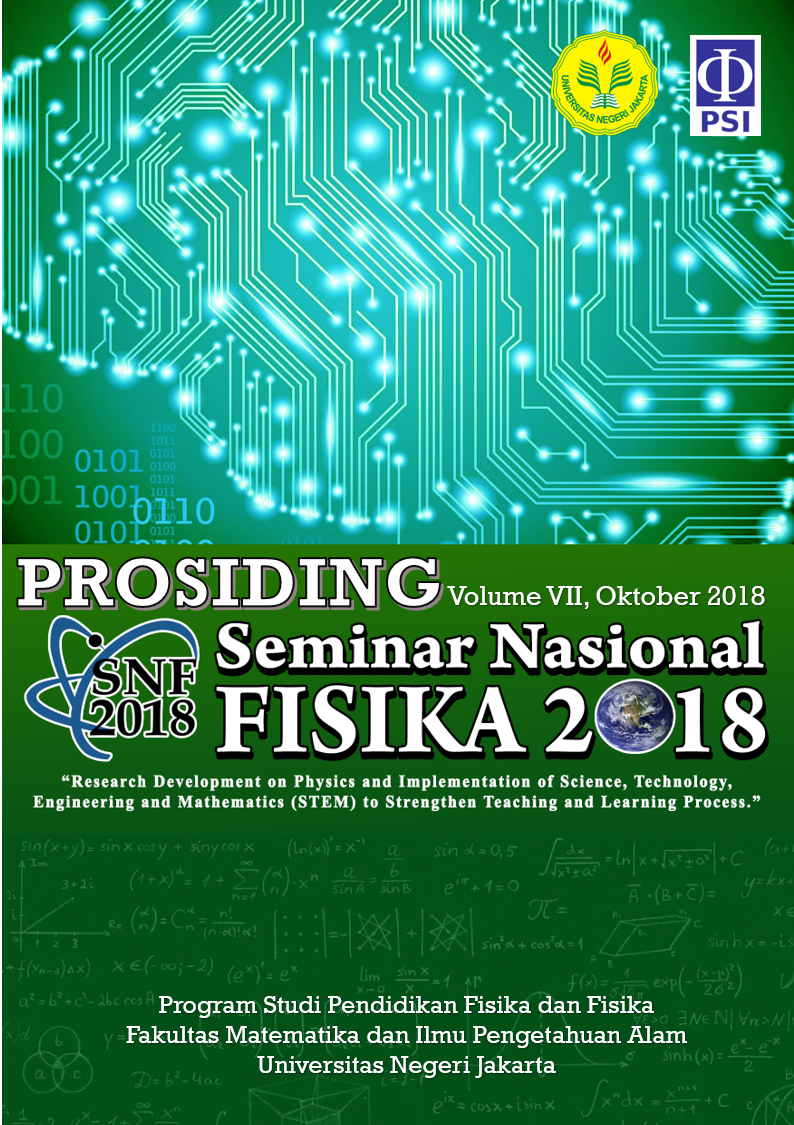OPTIMASI BESARAN FISIS YANG MEMPENGARUHI PROSES KONVERSI ENERGI (STUDI KASUS PERCOBAAN TARA KALOR MEKANIK DAN HUKUM JOULE)
DOI:
https://doi.org/10.21009/03.SNF2018.02.PA.10Abstract
Abstrak
Konsep Hukum kekekalan energi dapat diberikan melalui percobaan Tara Kalor Mekanik dan Percobaan Hukum Joule. Percobaan Tara Kalor Mekanik membuktikan konsep perubahan energi mekanik menjadi energi panas, sedangkan percobaan Hukum Joule membuktikan konsep perubahan energi listrik menjadi energi panas. Percobaan Tara Kalor Mekanik menggunakan 3 jenis calorimeter yaitu calorimeter tembaga kosong, calorimeter tembaga pejal, dan calorimeter aluminium pejal. Untuk mendapatkan perubahan energi mekanik menjadi energi panas yang optimum, calorimeter tembaga memerlukan kecepatan sudut lebih besar dibandingkan dengan calorimeter aluminium pejal. Kecepatan sudut optimum calorimeter tembaga kosong adalah 137 rpm, tembaga pejal 132 rpm, sedangkan aluminium pejal sebesar 113 rpm. Hal ini sesuai dengan besarnya kapasitas panas bahan calorimeter yang digunakan. Ketidaklinieran harga arus dengan perubahan panas disebabkan karena kalorimeter yang digunakan tidak murni bersifat adiabatik akibatnya ketika diberikan harga arus yang besar, suhu air pada kalorimeter cepat naik dan terjadi penyerapan suhu oleh lingkungan semakin besar. Sedangkan saat pemberian arus rendah, lebih kecil dari 1,5 A, suhu air pada kalorimeter mengalami kenaikan dengan waktu yang cukup lama. Dari hasil analisis ini disarankan apabila menggunakan arus yang kecil, waktu pemanasan perlu diperbesar. Dengan demikian dapat direkomendasikan pemberian harga arus yang optimum adalah pada pemberian arus sebesar 1,5 A – 2,5 A, dengan ratio Q/W mendekati 100%.
Kata-kata kunci: kalorimeter, Tarakalor mekanik, Hukum Joule
Abstract
The concept of energy conservation law is given through the experiment of the equivalence of mechanical heat and the experiment of Joule's Law. The experiment of the equivalence of mechanical heat proves the concept of changing mechanical energy into heat energy, while the Joule’s Law experiment proves the concept of changing electrical energy into heat energy. The experiment of the equivalence of mechanical heat uses three types of calorimeters that are water calorimeter, copper-block calorimeter, and aluminum-block calorimeter. To obtain mechanical energy changes to maximum heat energy, copper-block calorimeters require greater angular velocity than aluminum-block calorimeters. The optimum angular velocity of water calorimeter is 137 rpm, copper-block is 132 rpm, and aluminum-block is 113 rpm. This corresponds to the heat capacity of the calorimeter material used. The data obtained in Joule's law experiments of nonlinearity between the current given by the Q / W ratio is due to several factors. This is because the calorimeter used is not pure adiabatic, therefore when given the large currents, water temperature on the calorimeter rise fast, and absorption of temperature by the environment is greater. While the current smaller than 1.5 A, water temperature on the calorimeter has increased in a long time. From the results of this analysis, it is suggested when using a small current, and the heating time needs to be increased. It can be recommended that the maximum current is given at 1.5 A-2.5 A, with a Q / W ratio approaching 100%.
Keywords: calorimeter, Equivalence of Mechanical Heat, Joule’s Law





